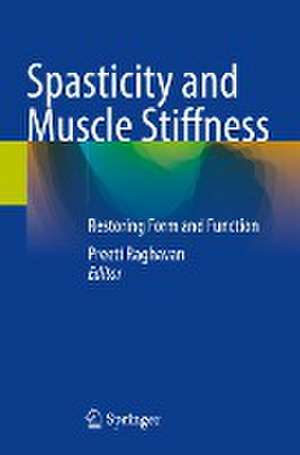Spasticity and Muscle Stiffness: Restoring Form and Function
Editat de Preeti Raghavanen Limba Engleză Paperback – 14 sep 2023
| Toate formatele și edițiile | Preț | Express |
|---|---|---|
| Paperback (1) | 652.26 lei 38-44 zile | |
| Springer International Publishing – 14 sep 2023 | 652.26 lei 38-44 zile | |
| Hardback (1) | 670.37 lei 38-44 zile | |
| Springer International Publishing – 13 sep 2022 | 670.37 lei 38-44 zile |
Preț: 652.26 lei
Preț vechi: 686.58 lei
-5% Nou
Puncte Express: 978
Preț estimativ în valută:
124.82€ • 135.54$ • 104.85£
124.82€ • 135.54$ • 104.85£
Carte tipărită la comandă
Livrare economică 19-25 aprilie
Preluare comenzi: 021 569.72.76
Specificații
ISBN-13: 9783030969028
ISBN-10: 3030969029
Pagini: 321
Ilustrații: XIX, 321 p. 111 illus., 105 illus. in color.
Dimensiuni: 155 x 235 mm
Ediția:1st ed. 2022
Editura: Springer International Publishing
Colecția Springer
Locul publicării:Cham, Switzerland
ISBN-10: 3030969029
Pagini: 321
Ilustrații: XIX, 321 p. 111 illus., 105 illus. in color.
Dimensiuni: 155 x 235 mm
Ediția:1st ed. 2022
Editura: Springer International Publishing
Colecția Springer
Locul publicării:Cham, Switzerland
Cuprins
PART 1.- 1. Neural basis of spasticity.- 2. Spasticity vs Spastic Movement Disorder.- 3. Clinical Assessment of the Syndrome of Spastic Paresis.- 4. Quantitative Measurement of Resistance to Passive Joint Motion in Chronic Stroke Survivors.- 5. Structural alterations in Spastic Muscle.- 6. Mechanisms of Development of Passive Mechanical Muscle Stiffness.- 7. Symptomatic and Functional After-Effects of the Syndrome of Spastic Paresis.- PART 2.- 8. Framework for the Treatment of Spasticity and Muscle Stiffness.- 9. Medical Exacerbation of Spasticity.- 10. Oral Spasmolytics.- 11. Intrathecal Baclofen Therapy.- 12. Treatment of Focal Muscle Overactivity using Botulinum Toxin Injections.- 13. Treatment of Focal Muscle Stiffness with Hyaluronidase Injections.- 14. Emerging Non-pharmacologic Therapies.
Notă biografică
Preeti Raghavan, MBBS, is Associate Professor of Physical Medicine and Rehabilitation and Neurology at the Johns Hopkins University School of Medicine and Director of the Center of Excellence for Stroke Recovery and Rehabilitation at the Sheikh Khalifa Stroke Institute. She also directs the Motor Recovery Research Laboratory where she leads a team of researchers to develop innovative therapeutic strategies to enhance recovery after stroke and other forms of brain injury.
Textul de pe ultima copertă
This book aids the practitioner in understanding the difference between spasticity and muscle stiffness, weighing old and new treatment options, and developing an appropriate treatment algorithm for a given patient. Spasticity is a common and disabling condition after neurologic injury such as stroke, spinal cord injury, multiple sclerosis, traumatic brain injury and cerebral palsy. Current treatments for spasticity may exacerbate other problems. Hence, there is a great need to develop a comprehensive understanding of the pathophysiology of spasticity and muscle stiffness, its assessment, and the various treatment options available to obtain the best results to restore joint alignment, movement, and function. This book is organized into two sections: Part I of the book deals with the pathophysiology and assessment of spasticity and muscle stiffness, and Part II of the book explains the rationale, framework, considerations, and evidence for various treatments for both spasticity and muscle stiffness. This comprehensive approach will enable physiatrists, neurologists, internists, and physical and occupational therapists to achieve the best possible outcomes for their patients.
Caracteristici
Offers a contemporary understanding of spasticity including central and peripheral mechanisms Details comprehensive management using traditional and cutting-edge approaches Includes practical treatment algorithms for improvement of movement and function
